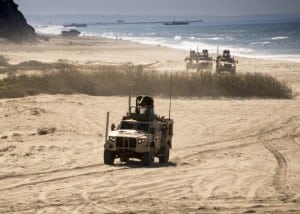Both the Army and Marine Corps are forging ahead with production of 56,000 Joint Light Tactical Vehicles (JLTV), although the trucks have failed to meet some maintenance-related performance thresholds, according to a Pentagon watchdog report.
In a heavily redacted report published May 2, the Pentagon Inspector General found that the service’s testing regimens were adequate, but the trucks did not demonstrate sufficient results to prepare the vehicle for full-rate production.

Service officials acknowledged the shortcomings but have favored staying on time and within budget over fixing maintenance-related problems, the IG found. Solutions to the maintenance issues are planned, as the IG recommends, as part of future production contracts, though the vehicle’s exact shortfalls are redacted from the 56-page report.
Soldiers and Marines in two separate test units completed operational test and evaluation of the truck in early April, clearing the way for a decision on whether to enter full-rate production on the truck built by Oshkosh Defense [OSK]. That decision is expected in the current fiscal year.
Testing began late February when 39 JLTVs Combat Tactical Vehicle and Combat Support Vehicle variants were split, between a Marine and an Army test unit. The IG found that during testing, the trucks were not meeting maintenance-related goals and that some lower-tier requirements were intentionally skipped in Oshkosh’s initial production contract offer.
The Army’s program executive office for combat support and combat service support, which oversees JLTV development, is sifting through the data gathered during testing in preparation for entering full-rate production. It has not published any performance data.
The services “developed adequate test plans but have not demonstrated effective test results to prepare the JLTV program for full-rate production,” the report said. In a review of eight maintenance-related vehicle performance requirements, the JLTV “exceeded the threshold and objective for some, exceeded the threshold requirement for some and failed to meet the threshold for others.”
Those requirements were operational availability, mean miles between operational mission failure, mean miles between hardware mission failure, maintenance ratio, mean time to repair, mean miles between essential function failure, fuel efficiency while the vehicle is moving and fuel efficiency while idling. How many of the eight requirements were met or not met and all performance data is redacted from the report.
An official familiar with the program said the vehicle in testing was averaging 16,000 miles between operational mission failures, or about seven times the operational requirement of 2,400 miles between breakdowns.
Reliability was heavily weighted in the Army’s selection of Oshkosh over a field of prototype vehicles made by Lockheed Martin [LMT], Humvee manufacturer AM General and others. During the engineering and manufacturing development (EMD) phase in which those companies participated, the Oshkosh vehicle demonstrated improved mission reliability over an uparmored Humvee by averaging 7,000 miles between operational mission failures compared with 2,900 miles for the Humvee.
The IG’s primary finding is partially redacted, including the title, which reads “The Army and Marine Corps Developed Adequate Test Plans and Have Begun Developing an [Redacted] for the JLTV Prior to Full-rate Production.”
Marine Assistant Deputy Commandant for Combat Development and Integration Lt. Gen.Robert Walsh, who is the requirements developer for the program, acknowledged and accepted the JLTV test results, the IG says.
Instead of changing requirements, the unmet maintenance-related vehicle performance requirements will not be included in the baseline vehicle to maintain program cost and schedule. Despite not meeting all maintenance related performance requirements, the JPO estimates JLTV operations and support costs will be reduced by $8.3 billion due to better fuel usage and better reliability than expected.
In addition, the JLTV requirements developer did not clearly define vehicle requirements. Army Test and Evaluation Command (ATEC) reported that the contractor – Oshkosh Defense is not mentioned by name – “misinterpreted” at least one requirement, but the exact performance measurement is redacted. That misunderstanding led Oshkosh to remove a redacted component that was a lower-tiered requirement to shave cost from its initial production contract proposal.
According to JPO officials, once the solution is tested, it will be integrated into production vehicles through an engineering change proposal. As part of the contract modifications, [Redacted] will be provided to the government for vehicles that will undergo multi-Service OT&E, which began in February.
The Army and Marine Corps plan to purchase a total 56,340 JLTVs through fiscal 2037. The current split is 49,099 trucks for the Army and 7,241 for the Marines at a total lifecycle cost of $48 billion, according to the IG. That figure includes of $930.7 million for research, development, test, and evaluation; $19.4 billion for procurement and $27.6 billion for operations and support (O&S).

 By
By 

















